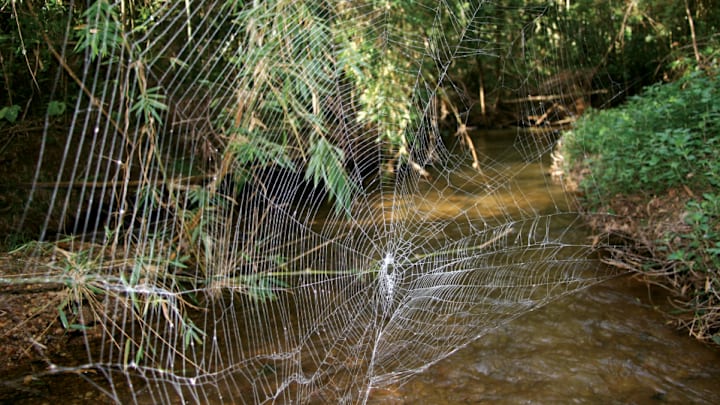Walking into a spider web might make you panic, even if it’s only a few feet wide. Now imagine colliding into one over 80 feet long. That’s unlikely, but thanks to the Darwin’s bark spider, it’s not impossible.
The BBC YouTube video below highlights the arachnid’s web-weaving skills. Its silk structure is the world’s largest web, spanning up to 25 meters, or about 82 feet. Though its creations are massive, the Darwin’s bark spider is far from most enormous spider ever discovered. That title goes to the Goliath birdeater, which weighs 6 ounces—more than some newborn puppies. iNaturalist shares that the female Darwin’s bark spider grows to be about 22 millimeters (0.9 inches) at most.
So how can such a small creature create such a vast structure? The Darwin’s bark spider begins the monumental task by spraying multiple long silk strands. The threads fan out slightly, acting like small kites as they ride the breeze. The arachnid knows to clump the strands together every few seconds to prevent them spreading too far apart. The wind will eventually blow the strands into a single line, which serves as a base bridge for the web. Then, the spider will anchor it and start weaving the biggest web known to scientists.
Not only is the Darwin’s bark spider’s web gigantic, but it’s also incredibly durable. The spider’s silk is the strongest biological material ever found. More specifically, it’s 10 times stronger than a same-sized piece of Kevlar, a tough fiber that can be used for flame-resistant clothing and military protective equipment.
You might assume that a web that size is meant to catch monstrous prey. But according to iNaturalist, the Darwin’s bark spider uses its web to trap small, flying insects that hang out near water, such as mayflies. Though its prey isn’t any larger than that of a regular spider, its exceptional web can hold 30 of the insects at once.
Read More About Animals:
